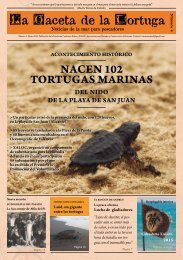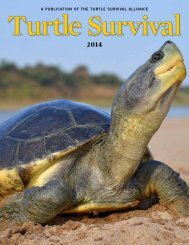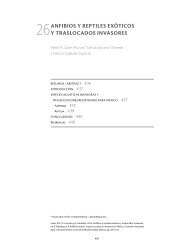tsrp63entire
tsrp63entire
tsrp63entire
Create successful ePaper yourself
Turn your PDF publications into a flip-book with our unique Google optimized e-Paper software.
5.1.6 Topic 6—Habitat restoration<br />
Native frogs were once widely distributed throughout New Zealand (Worthy 1987b). However,<br />
all surviving native frog species now have significantly reduced distributions. While the agents<br />
of decline for native frogs are not yet fully understood and historical declines may have been<br />
caused by a combination of factors, it is likely that habitat loss contributed to past population<br />
declines and extinctions. Frogs have specific temperature and humidity requirements, and rely<br />
upon suitable damp refuges (such as those present in forest habitats) to survive. Deforestation<br />
or severe habitat modification can alter the temperature and humidity in frog habitats, rendering<br />
them unsuitable. Unless there is suitable habitat for native frogs, remnant populations cannot<br />
expand and may eventually become extinct.<br />
Evidence of the effects of deforestation on native frogs can be seen in Maud Island frog and<br />
Hamilton’s frog. By 1911, Maud Island had been cleared of forest and converted to grazing, with<br />
only one catchment retained in forest cover (Sherwood 1912, cited in Bell 1995). Maud Island<br />
frogs survived only within the forested catchment, becoming extinct over the rest of the island.<br />
Similarly, Stephens Island (where Hamilton’s frog is found) was entirely cleared of native<br />
vegetation, so that the frogs only survived in very low numbers in a boulder bank, in which there<br />
were sufficient damp refuge sites under the rocks. Mainland frog populations are also currently<br />
restricted to areas of remnant native forest or to specific habitat in modified forest<br />
(e.g. Hochstetter’s frog can survive on stream edges in forestry plantations).<br />
Issues<br />
Issue 6.1:<br />
Land use activities have reduced and modified native frog habitat.<br />
Objective and actions<br />
Objective 6.1:<br />
To protect selected frog populations through habitat restoration at targeted sites.<br />
Action Accountability Priority<br />
6.1 Identify sites where habitat restoration is necessary<br />
to ensure the survival of a native frog species or<br />
ESU by 2015.<br />
6.2 Initiate restoration at the sites identified in<br />
Action 6.1 by 2017.<br />
6.3 Identify sites where habitat restoration will be<br />
necessary for frog population expansion by 2018.<br />
Recovery Group<br />
Relevant Conservation Services Group staff<br />
Recovery Group<br />
Relevant Conservation Services Group staff<br />
Science and Capability Group<br />
Recovery Group<br />
Essential<br />
High<br />
Medium<br />
5.1.7 Topic 7—Capability<br />
The management and monitoring of native frogs requires specific research and technical skills.<br />
To carry out techniques such as photographic monitoring, toe-tip clipping or site occupancy<br />
monitoring, individuals need to be able to detect cryptic species, and must have frog handling<br />
skills in the manipulation of body posture and toes. Specific expertise is also required for the<br />
captive management of native frogs. However, staff turnover in the past has led to a lack of<br />
continuity in native frog projects and the loss of specific skills.<br />
Issues<br />
Issue 7.1:<br />
Issue 7.2:<br />
Staff turnover can lead to a lack of continuity in frog monitoring or management<br />
projects.<br />
Specific research and technical skills are required to guide and inform frog recovery.<br />
20 Bishop et al.—Native frog recovery plan, 2013–2018





